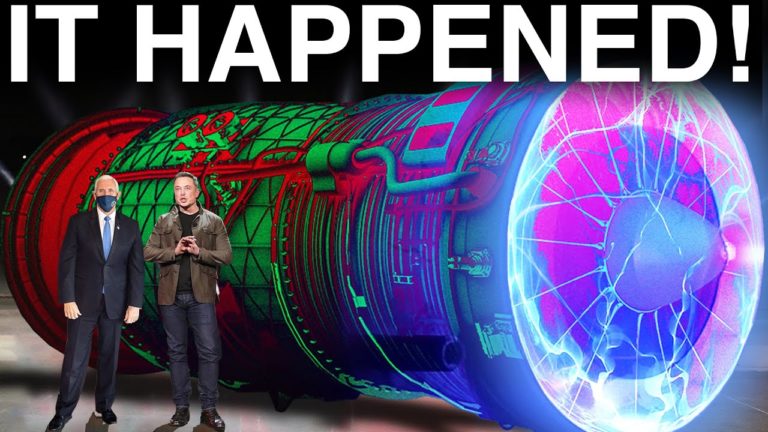IT HAPPENED! Elon Musk & NASA FINALLY Reveal New Light Speed Engine!
Is it possible that Elon Musk and NASA have finally defied the law of physics with their latest development? Perhaps they have because NASA is on the verge of creating a near-light-speed engine that defies physics laws, a concept for an engine that can accelerate to 99 percent the speed of light without using any fuel.
That might sound like something out of a science fiction film, but it is not. One of NASA’s engineers is working on something similar, and it has the potential to defy physics.
What are the plans for these engines? What will it use as fuel if it can’t use propellant? Will a human be able to travel in a vehicle with a thruster like this? Is the possibility for fast space travel already here?
These are the questions going through most people’s minds at the moment.
We’ll find out the answers to these questions and more. So ensure that you watch to the end. You don’t want to miss out on anything.
Let’s get started, shall we? Humanity has dreamed of crossing the astronomical distances separating us from the ultimate alien destinations for centuries, ever since we realized that every star we see in the night sky is a Sun just like ours, with possibly its solar system, planets, and maybe even life.
Even the closest star is more than four light-years away, while NASA’s Juno mission achieved the fastest speed a human-built spacecraft has ever
traveled at, that is at 74 km/sec (46 mi/sec). Even at that rate, reaching the nearest star would take more than 4,000 years.
We have a problem with our human drive to travel everywhere and examine everything in space. This is a significant problem.
After all, it is space. It’s way too big. Even if we traveled at the fastest possible speed, it would take
us years to reach our nearest star. Elon Musk’s private spaceflight business SpaceX was founded with the idea of making life multi-planetary. He claims that relocating humans to other worlds, such as Mars, could save humanity in the event of a calamity on Earth, such as a massive asteroid hit.
In 2016, Elon Musk said that there would be two paths for history to take. One option is that we stay on Earth indefinitely, with an ultimate extinction event.
The alternative is to become a spacefaring civilization, and a multi- planet species, which he hopes we would agree is the right way to go.
The SpaceX founder has frequently expressed his desire to develop settlements on Mars. Payments, he says, would require a significant number of people to become self-sustaining. To make this fantasy a reality, a capable automobile is needed. Still, the current limits of our technology and physics laws are the two limiting factors of space travel. Advances in fields such as laser sails, nuclear rather than chemical propulsion, or producing and controlling antimatter or dark matter could provide a game-changing technological breakthrough, and they appear to be close. Another human desire is to find solutions to significant problems.
NASA engineer David Burns has been doing precisely that in his spare time. He
claims to have built an engine that can accelerate to 99 percent the speed of light without fuel. He has posted it to NASA’s Technical Reports Server under the name “Helical Engine,” It works on paper by exploiting how mass may change at relativistic speeds, which are close to the speed of light in a vacuum.
It hasn’t been professionally reviewed yet. This story has created curiosity comparable to that seen in the early days of the EM Drive, which is understandable.
Yes, there have been reports that the engine may ‘defy physics.’ To put things in perspective, the EM Drive was NASA’s initial step into the idea of really trying to develop a faster-than-light engine. So, what exactly is the EM Drive? EM Drive is a radio frequency resonant cavity thruster concept first developed in 2001 by Roger Shawyer, a British Chartered Electrical Engineer with 48 years of experience in the Space and Defence industries.
Internally reflected microwaves are said to generate thrust, violating the law of conservation of momentum and other fundamental considerations.
The device has been dubbed the “Impossible Drive” by the media. Explanations for how the EmDrive might work go beyond what is known about physics. Perhaps it’s interacting with the vacuum energy of space- quantum time, even though space quantum time doesn’t allow anything to push off of it.
Perhaps our sense of forwarding motion has been destroyed. Maybe it’s brand-new physics, as the EmDrive tests have revealed.
There is no official design for this device, and none of the people who claim to have invented it has committed to detailing how it might work as a thruster or what components make it up, making it hard to tell whether a given thing is one.
In 2016, NASA’s Advanced Propulsion Physics Laboratory reported seeing
Do not forget to share your opinion with us to provide you with the best posts !




Two of the most obvious questions need to be addressed. 1, What happens when ‘a craft’ at that velocity encounters another object and it doesn’t want to get out of the way? 2. Going that fast is all well and fine but how is it slowed down/stopped without changing the direction or causing disintegration?